Abstract
The accuracy of the RapID-ANA II system (Innovative Diagnostic Systems, Inc., Atlanta, Ga.) was evaluated by comparing the results obtained with that system with results obtained by the methods described by the Virginia Polytechnic Institute and State University. Three hundred anaerobic bacteria were tested, including 259 clinical isolates and 41 stock strains of anaerobic microorganisms representing 16 genera and 48 species. When identifications to the genus level only were included, 96% of the anaerobic gram-negative bacilli, 94% of the Clostridium species, 83% of the anaerobic, nonsporeforming, gram-positive bacilli, and 97% of the anaerobic cocci were correctly identified. When correct identifications to the genus and species levels were compared, 86% of 152 anaerobic gram-negative bacilli, 76% of 34 Clostridium species, 81% of 41 anaerobic, nonsporeforming, gram-positive bacilli, and 97% of 73 anaerobic cocci were correctly identified. Eight isolates (3%) produced inadequate identification in which the correct identification was listed with one or two other possible choices and extra tests were required for separation. A total of 9 isolates (3%) were misidentified by the RapID-ANA II panel. Overall, the system was able to correctly identify 94% of all the isolates to the genus level and 87% of the isolates to the species level in 4 h by using aerobic incubation.
Full text
PDF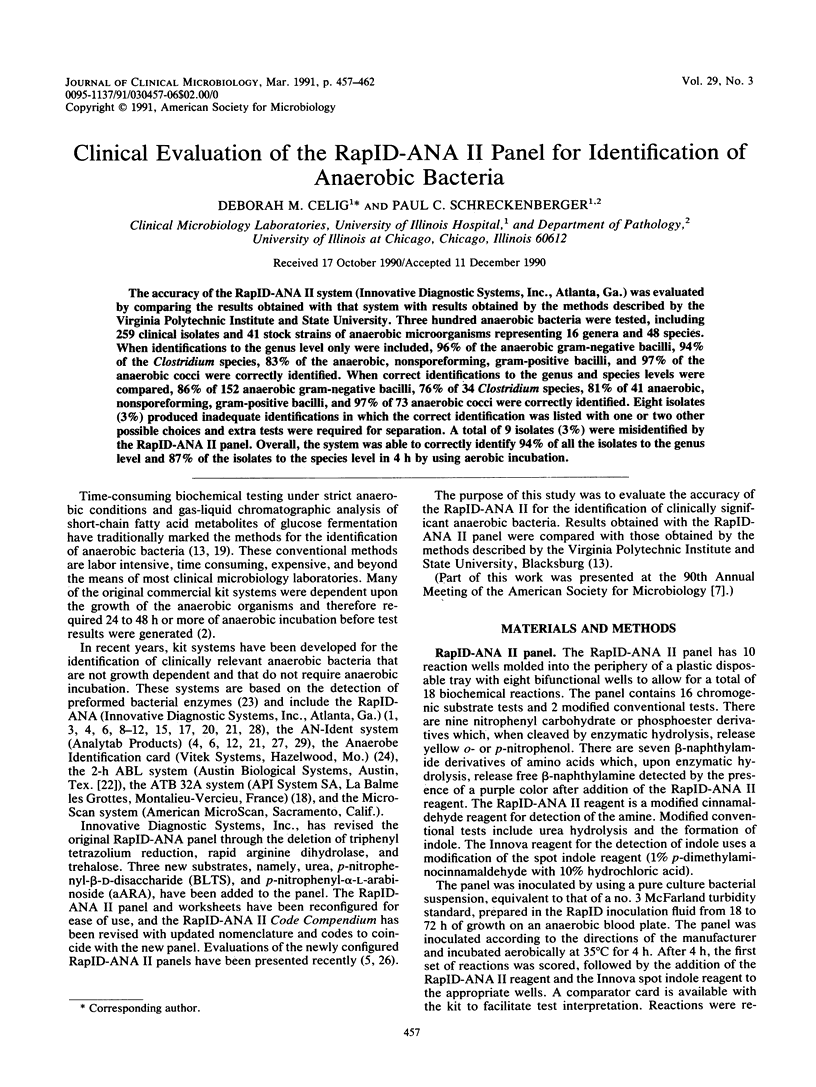
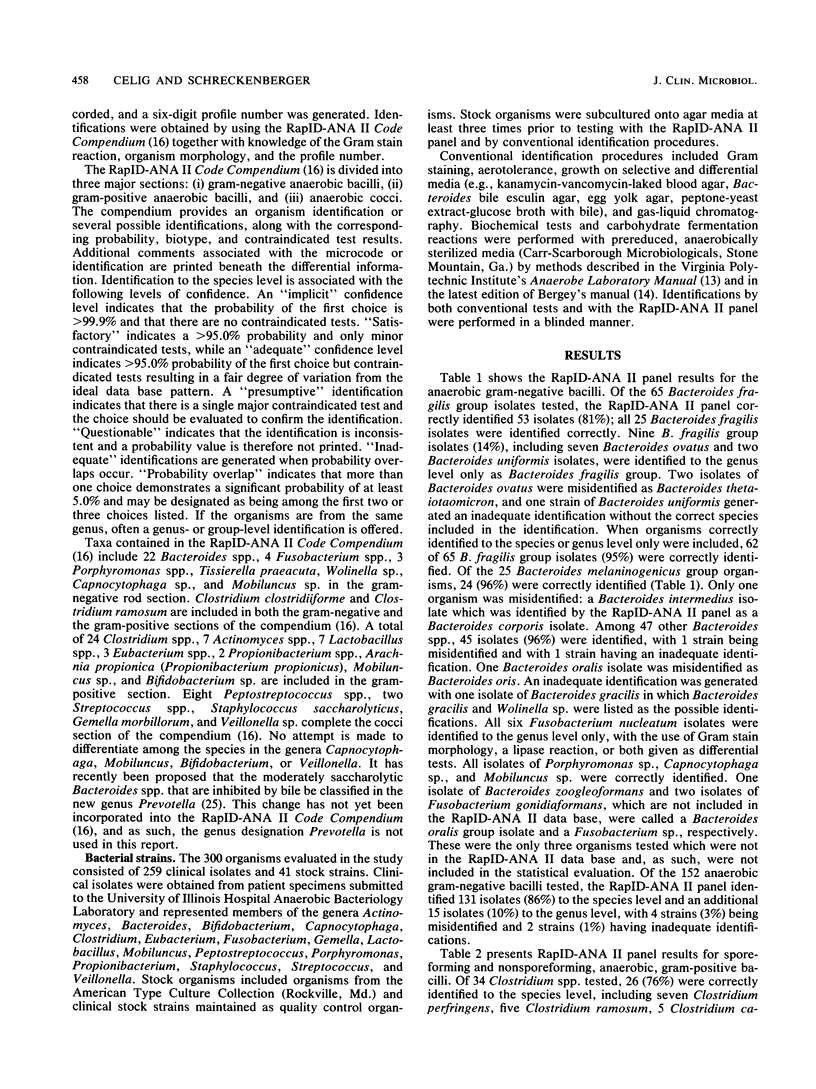
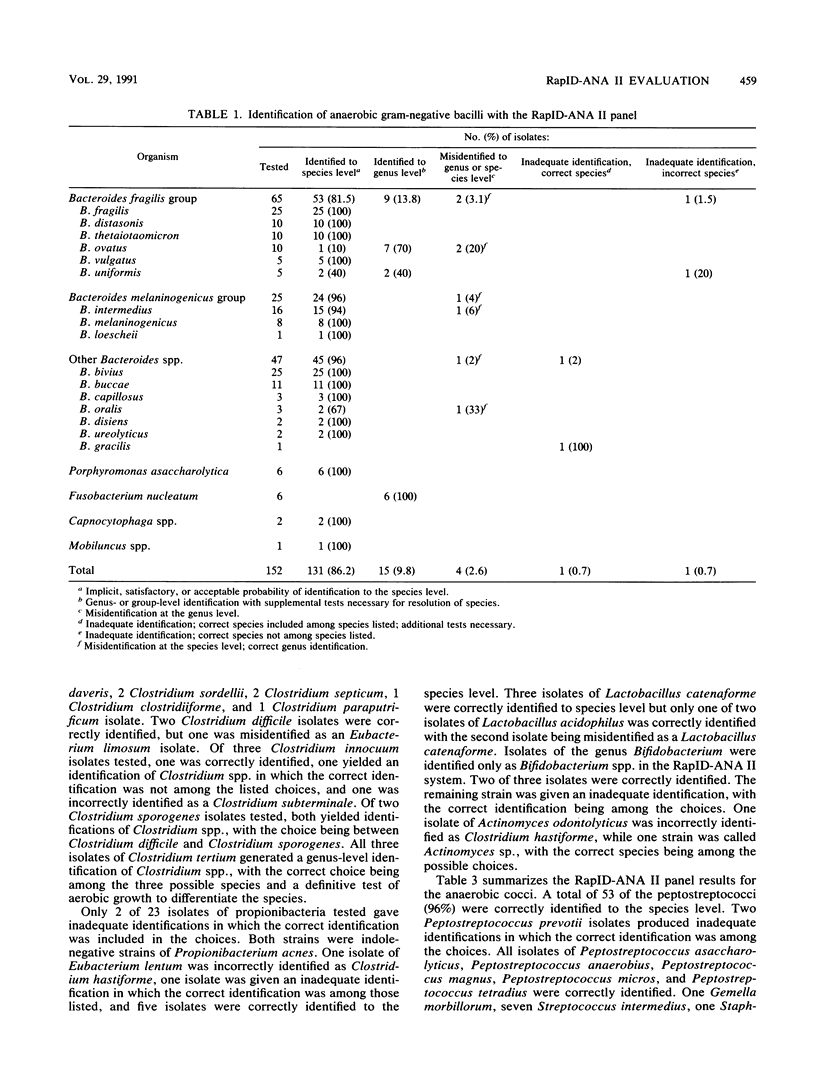
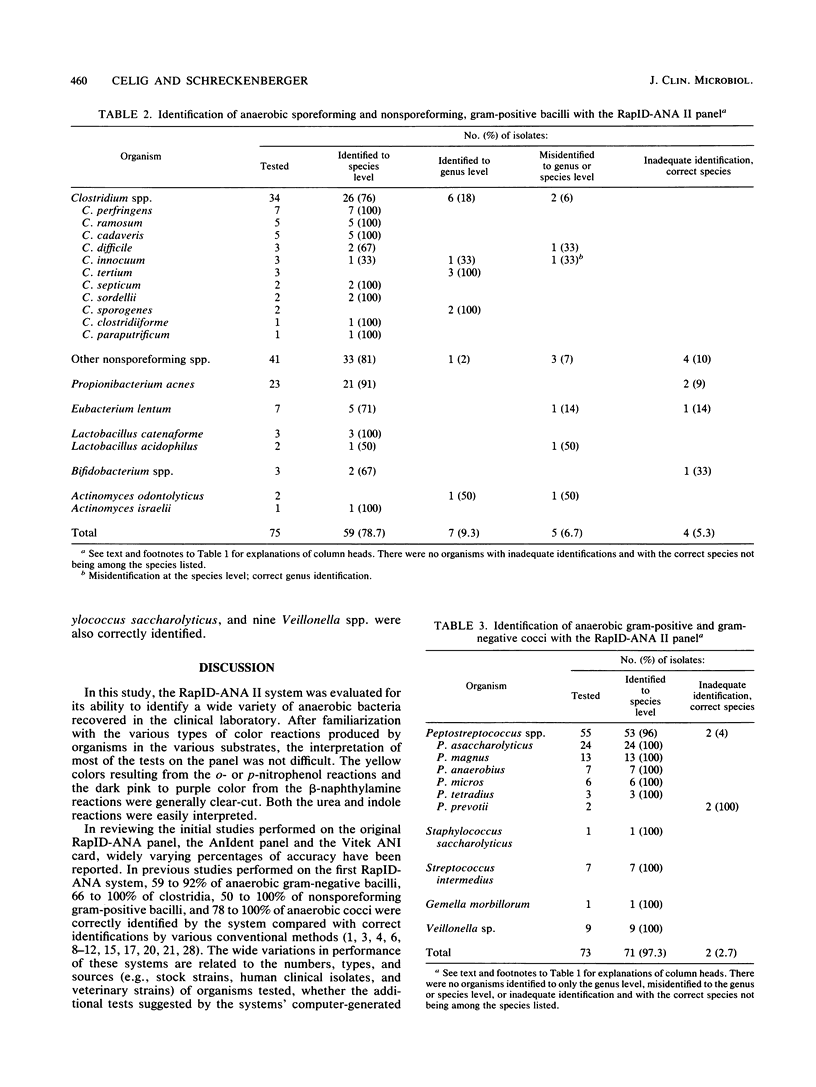

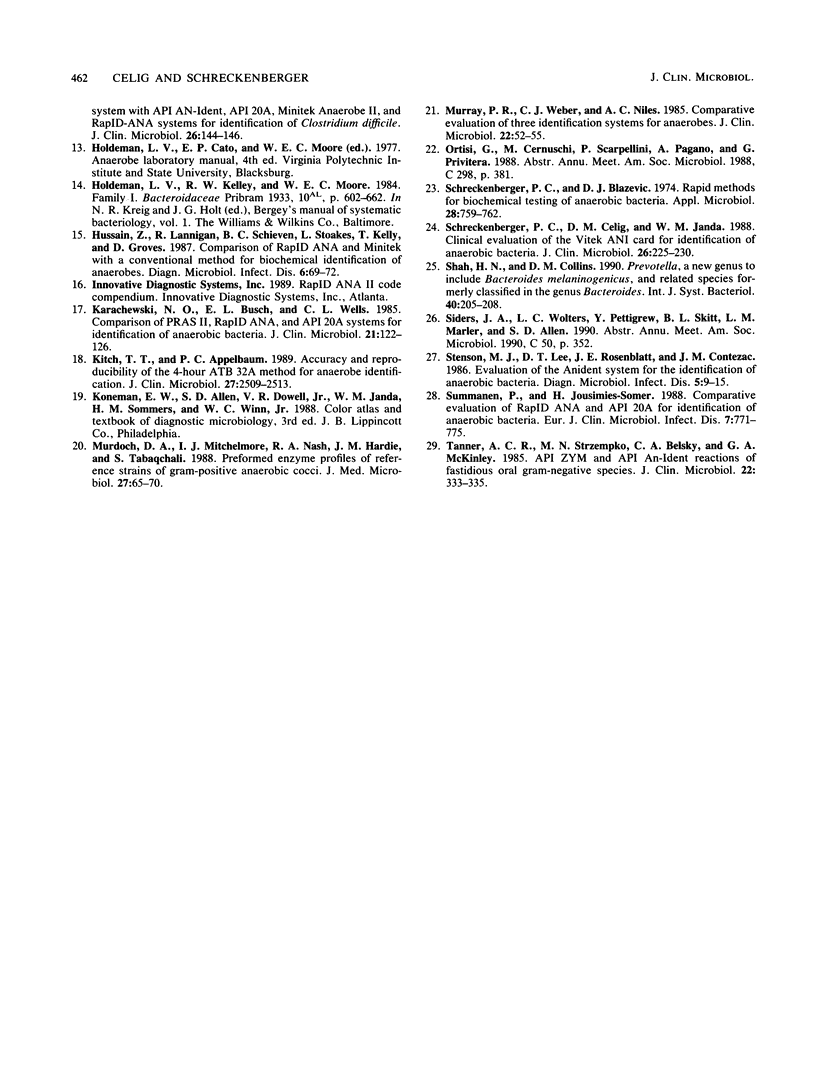
Selected References
These references are in PubMed. This may not be the complete list of references from this article.
- Adney W. S., Jones R. L. Evaluation of the RapID-ANA system for identification of anaerobic bacteria of veterinary origin. J Clin Microbiol. 1985 Dec;22(6):980–983. doi: 10.1128/jcm.22.6.980-983.1985. [DOI] [PMC free article] [PubMed] [Google Scholar]
- Appelbaum P. C., Kaufmann C. S., Depenbusch J. W. Accuracy and reproducibility of a four-hour method for anaerobe identification. J Clin Microbiol. 1985 Jun;21(6):894–898. doi: 10.1128/jcm.21.6.894-898.1985. [DOI] [PMC free article] [PubMed] [Google Scholar]
- Bate G. Comparison of Minitek Anaerobe II, API An-Ident, and RapID ANA systems for identification of Clostridium difficile. Am J Clin Pathol. 1986 Jun;85(6):716–718. doi: 10.1093/ajcp/85.6.716. [DOI] [PubMed] [Google Scholar]
- Burlage R. S., Ellner P. D. Comparison of the PRAS II, AN-Ident, and RapID-ANA systems for identification of anaerobic bacteria. J Clin Microbiol. 1985 Jul;22(1):32–35. doi: 10.1128/jcm.22.1.32-35.1985. [DOI] [PMC free article] [PubMed] [Google Scholar]
- Dellinger C. A., Moore L. V. Use of the RapID-ANA System to screen for enzyme activities that differ among species of bile-inhibited Bacteroides. J Clin Microbiol. 1986 Feb;23(2):289–293. doi: 10.1128/jcm.23.2.289-293.1986. [DOI] [PMC free article] [PubMed] [Google Scholar]
- Downes J., Andrew J. H. Evaluation of the RapID ANA system as a four-hour method for anaerobe identification. Pathology. 1988 Jul;20(3):256–259. doi: 10.3109/00313028809059503. [DOI] [PubMed] [Google Scholar]
- Gulletta E., Amato G., Nani E., Covelli I. Comparison of two systems for identification of anaerobic bacteria. Eur J Clin Microbiol. 1985 Jun;4(3):282–285. doi: 10.1007/BF02013653. [DOI] [PubMed] [Google Scholar]
- Hussain Z., Lannigan R., Schieven B. C., Stoakes L., Kelly T., Groves D. Comparison of RapID-ANA and Minitek with a conventional method for biochemical identification of anaerobes. Diagn Microbiol Infect Dis. 1987 May;7(1):69–72. doi: 10.1016/0732-8893(87)90073-3. [DOI] [PubMed] [Google Scholar]
- Karachewski N. O., Busch E. L., Wells C. L. Comparison of PRAS II, RapID ANA, and API 20A systems for identification of anaerobic bacteria. J Clin Microbiol. 1985 Jan;21(1):122–126. doi: 10.1128/jcm.21.1.122-126.1985. [DOI] [PMC free article] [PubMed] [Google Scholar]
- Kitch T. T., Appelbaum P. C. Accuracy and reproducibility of the 4-hour ATB 32A method for anaerobe identification. J Clin Microbiol. 1989 Nov;27(11):2509–2513. doi: 10.1128/jcm.27.11.2509-2513.1989. [DOI] [PMC free article] [PubMed] [Google Scholar]
- Murdoch D. A., Mitchelmore I. J., Nash R. A., Hardie J. M., Tabaqchali S. Preformed enzyme profiles of reference strains of gram-positive anaerobic cocci. J Med Microbiol. 1988 Sep;27(1):65–70. doi: 10.1099/00222615-27-1-65. [DOI] [PubMed] [Google Scholar]
- Murray P. R., Weber C. J., Niles A. C. Comparative evaluation of three identification systems for anaerobes. J Clin Microbiol. 1985 Jul;22(1):52–55. doi: 10.1128/jcm.22.1.52-55.1985. [DOI] [PMC free article] [PubMed] [Google Scholar]
- Schreckenberger P. C., Blazevic D. J. Rapid methods for biochemical testing of anaerobic bacteria. Appl Microbiol. 1974 Nov;28(5):759–762. doi: 10.1128/am.28.5.759-762.1974. [DOI] [PMC free article] [PubMed] [Google Scholar]
- Schreckenberger P. C., Celig D. M., Janda W. M. Clinical evaluation of the Vitek ANI card for identification of anaerobic bacteria. J Clin Microbiol. 1988 Feb;26(2):225–230. doi: 10.1128/jcm.26.2.225-230.1988. [DOI] [PMC free article] [PubMed] [Google Scholar]
- Shah H. N., Collins D. M. Prevotella, a new genus to include Bacteroides melaninogenicus and related species formerly classified in the genus Bacteroides. Int J Syst Bacteriol. 1990 Apr;40(2):205–208. doi: 10.1099/00207713-40-2-205. [DOI] [PubMed] [Google Scholar]
- Stenson M. J., Lee D. T., Rosenblatt J. E., Contezac J. M. Evaluation of the AnIdent system for the identification of anaerobic bacteria. Diagn Microbiol Infect Dis. 1986 May;5(1):9–15. doi: 10.1016/0732-8893(86)90086-6. [DOI] [PubMed] [Google Scholar]
- Summanen P., Jousimies-Somer H. Comparative evaluation of RapID ANA and API 20 A for identification of anaerobic bacteria. Eur J Clin Microbiol Infect Dis. 1988 Dec;7(6):771–775. doi: 10.1007/BF01975045. [DOI] [PubMed] [Google Scholar]
- Tanner A. C., Strzempko M. N., Belsky C. A., McKinley G. A. API ZYM and API An-Ident reactions of fastidious oral gram-negative species. J Clin Microbiol. 1985 Sep;22(3):333–335. doi: 10.1128/jcm.22.3.333-335.1985. [DOI] [PMC free article] [PubMed] [Google Scholar]


